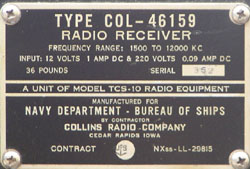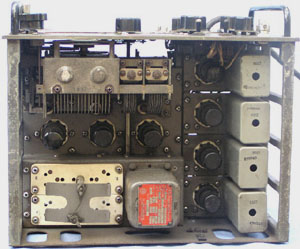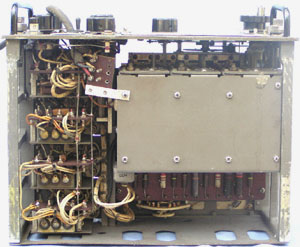General Description
The equipment covers the frequency range 1500 - 12000 kc. The transmitter is capable of 25 watts on telegraphy and 10 watts on telephone.
The equipment was much prized by amateurs after the war because of the high stability associated with the VFO in the transmitter. It must surely rank as one of the first "modular" sets constructed. The stability is in large part due to the cast chassis which is very substantial.
It is believed that the Snowy Mountains Authority (Australia) used TCS equipment on the original horseback surveys of the Snowy Mountains area prior to the building of the dams, tunnels and power stations.
Like most U.S. Navy equipment, there was a large chest of spare parts to accompany the set. This contained every part of the set apart from the metal work so that on the spot repairs could be carried out.
Technical Data
 The valve line up is as follows:
The valve line up is as follows:
Transmitter:
V101, 102, 103 - 12A6 Master Osc, Crystal Osc and Buffer doubler.
V104,105 - 1625 Power Amplifiers V106, 107 - 1625 Modulators.
Receiver
:V201 12SK7 RF Amp, V202 l2SA7 mixer, V203 12A6 Oscillator, V204, 205 12SK7 IF Amplifiers, V206 l2SQ7 Detector/BFO, V207 12A6 Audio Amplifier.
The receiver delivers 6mw audio power for 15 microvolts input. Audio output is 500 ohms at 1.5 watts.
The equipment normally operated off a 15 foot whip antenna.
Associated equipment included an antenna tuning unit and a remote control unit.
The receive and low level transmit voltage was 225v, while the high power transmit stages operated on 400 volts.


